Because of their hardiness and minimal care requirements, succulents are a favorite among those who like growing plants inside and outdoors. Even novices may easily care for them since they need little maintenance. To maintain their succulents healthy and blooming, many individuals, however, are unsure of how often they should water them.
How Often Do You Water Succulents?
Normally, Succulents are watered once each week during the growth season and once every two weeks during the dormant season is the recommended for indoor succulents When they are growing, outdoor succulents should be watered every two to three weeks, and then every four to six weeks when they are dormant.
We’ll go over everything you need to know about watering succulents in this in-depth guide, including how much and how often you should water them, factors that affect their watering requirements, and care recommendations.
Understanding Succulent Watering Needs
Let’s look more closely at why succulents have certain watering requirements before we get into the intricacies of watering them. Succulents have evolved to retain water in their stems, leaves, and roots in order to survive in dry climates with little rainfall.
As an Amazon Associate we earn from qualifying purchases.
Table of Contents
They can hold water for a long time since their leaves are often thick and meaty. This adaptability makes them resistant to drought and ideal for folks who may neglect to water their plants often.
Succulents do not, however, eliminate the requirement for water simply because they can go for extended periods of time without it. Knowing how often to water your succulents is very essential to their life and wellness.
How Much and How Often to Water Succulents
Let’s talk about how much and how often you should water your succulents now that you have a basic awareness of the factors that affect this decision.
How Often to Water Succulents Indoors and Outdoors
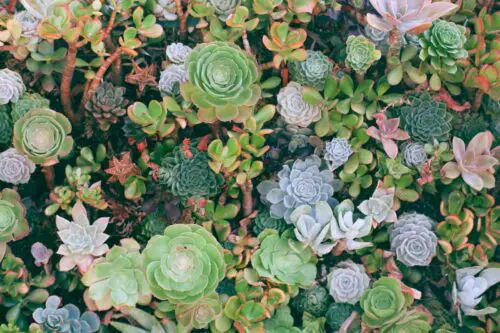
The season, container size, and other factors described above will all affect the frequency of watering your succulent plants. Normally, once per week during the growth season and once every two weeks during the dormant season is the recommended amount of watering for indoor succulents. When they are growing, outdoor succulents should be watered every two to three weeks, and then every four to six weeks when they are dormant. According to wvu.edu, watering succulent infrequently either once a week or may less than a week can make your succulent healthy.
Watering Frequency for Succulents in Containers and In-Ground
Since they have less soil to hold water than those planted in the ground, succulents in containers need watering more frequently. When the top inch of soil feels dry to the touch, it’s a good general guideline to water your container plants. In contrast, you may wait until the top few inches of soil are completely dry before watering in-ground succulents.
How Much Water Do Succulents Need?
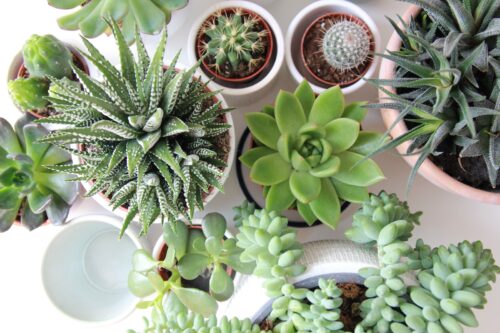
Less is more when it comes to watering succulents. Succulents can retain water in their leaves, stems, and roots and are suited to live in dry environments. Root rot, which may be lethal for the plant, can result from overwatering. In order to prevent extra water from building up in the soil, a common rule of thumb is to water your succulent until the water drains out of the bottom of the container.
How to Take Care of Succulents
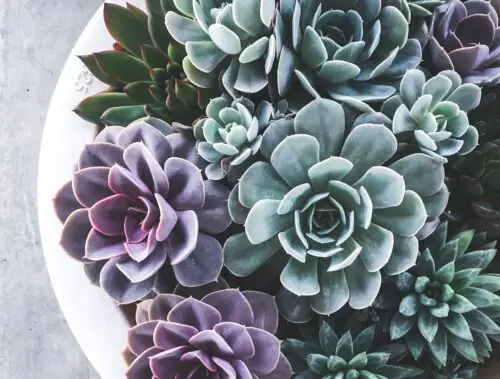
Let’s first examine the fundamentals of succulent care before we get into watering succulents. The development and health of your succulent plants depend on proper care. The following advice will help you care for your succulents:
- Pick the right potting soil: Succulents need a soil that drains well and doesn’t hold on to water for too long. To promote proper drainage, use potting soil that includes sand, perlite, or pumice.
- Sunlight should be available: Succulents need plenty of bright, indirect light to grow. If you live in a place with little natural light, place your plants next to a window that faces south or beneath grow lights.
- Succulents enjoy warm, dry environments, so regulate the temperature and humidity. As high humidity can lead to fungus diseases, avoid placing your plants there. Fahrenheit should be maintained between 60 and 80.
- Fertilize infrequently: Succulents don’t need fertilizer often, but infrequent feedings may encourage growth and blooming. Utilize a low-nitrogen fertilizer once or twice a year as directed by the manufacturer.
Factors That Affect How Often You Need to Water Succulents
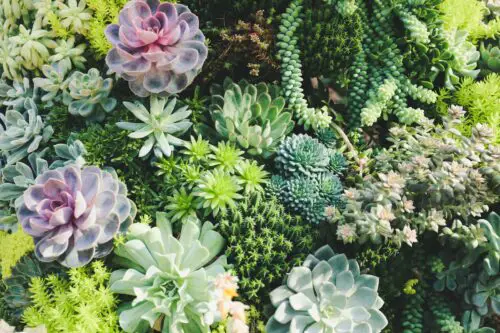
Several factors affect how often you need to water your succulents. Understanding these factors can help you create a watering schedule that suits your plant’s needs.
Season
How often you need to water your succulents depends on the season. Your plants can need watering once a week or perhaps more often during the hot, dry summer months. Your plants could need less regular watering throughout the winter since the air is colder and more humid.
Container Size
Your succulent’s container size will also affect how often you need to water it. Compared to those planted in bigger containers, succulents placed in tiny pots need more regular watering. Small pots have less soil, which causes the water to evaporate more quickly.
12 Succulents Worth Knowing
The sort of succulent you have will determine how often you should water it. Each of the roughly 60 distinct families of succulent plants has specific watering requirements. Some of the most well-known succulents worth knowing are listed below:
- Aloe Vera
- Echeveria
- Jade plant
- Haworthia
- Sedum
- Crassula
- Kalanchoe
- Agave
- Gasteria
- Sempervivum
- String of pearls
- Ponytail palm
Amount of Light
The amount of light your succulent gets will affect how often it needs to be watered. More frequent watering may be necessary for plants in bright, indirect light compared to those in lower light levels. This is due to the plant’s active photosynthetic process, which uses water to create energy. Although they can lose water through transpiration, succulents that are exposed to direct sunlight for extended periods of time may require less water.
Humidity
The frequency of watering succulents is also affected by humidity levels. Succulents don’t need a lot of humidity since they are suited to arid environments. High humidity levels might result in fungi illnesses and plant rot. As a result, it is crucial to make sure your plants have enough air and to refrain from overwatering them.
Signs Your Succulent Needs Water
Let’s have a look at some indicators that your succulent needs water now that you know the factors that affect how often you should water it. Here are some of the crucial indications to watch out for:
Wrinkled or Shriveled Leaves
Wrinkled or shriveled leaves are one of the most obvious indications that your succulent lacks water. A succulent will begin to utilize the water that is stored in its leaves or stems if it doesn’t get enough water. As a consequence, the leaves begin to wither and the plant may begin to seem wilted.
Soft or Mushy Leaves
The leaves of your succulent, however, can turn mushy or squishy if it is overwatered. Overwatering might result in the rot of the plant’s roots and its eventual death.
Dry Soil
It’s a good sign that your plant needs water if the soil surrounding your succulent is dry. Inserting your finger approximately an inch into the soil will allow you to measure the soil’s moisture content. It’s time to water your succulent if it’s dry.
Slow Growth
Your succulent may not be receiving enough water if it isn’t growing as quickly as it formerly did. In order to thrive, succulents need water, and if they don’t receive enough, their growth may be slowed.
How to Water Succulent Plants (indoors and outdoors)
Let’s talk about how to water succulent plants now that we’ve looked at the factors that affect watering frequency. It takes skill to water succulents without drowning them or overwatering them. For watering succulent plants, consider the following advice:
- Before watering your succulent, measure the moisture content of the soil. To check for moisture, insert your finger approximately one inch into the soil. The time has come to water if the soil seems dry.
- Water sparingly yet deeply: When watering, make sure the soil is completely saturated. To ensure that the roots can thoroughly take the liquid, water deeply yet rarely. Avoid shallow watering since it may cause root rot.
- Watering cans and drip irrigation systems are ideal for watering succulents. They ensure that the water gets to the roots directly and let you control how much you apply.
- Water your plants early in the day so that any extra water may evaporate before dusk falls. If plants are watered at night, surplus moisture may collect around the roots and result in fungus illnesses.
The Importance of Soil and Pot Selection for Watering Succulents
Your succulent plants’ watering needs may be considerably affected by the kind of soil and container you choose. A soil that drains effectively and does not hold too much water is necessary for succulents. To promote proper drainage, use potting soil that includes sand, perlite, or pumice. To enable extra water to flow out, the pot needs drainage holes.
The size of the pot will also affect the amount of water needed. Compared to those planted in bigger containers, succulents placed in tiny pots need more regular watering. Small pots have less soil, which causes the water to evaporate more quickly. Selecting the proper container size for your succulent plants is crucial.
Propagating Succulent Leaves and Babies: Watering Tips
Growing succulent leaves and offspring is a satisfying and enjoyable process. To make sure your new plants thrive, you must use precise watering methods. The following advice is for watering propagated succulent leaves and young:
- Mist frequently: To properly root, propagated succulent leaves and infants need high humidity levels. To make sure they have adequate moisture to form roots, mist them often.
- Use just a little amount of water: Overwatering propagated succulents might cause rotting. Water in moderation, making sure the soil is damp but not drenched.
- Use a well-draining soil mixture: To avoid rotting, propagated succulent leaves and young plants need well-draining soil. To promote proper drainage, use potting soil that includes sand, perlite, or pumice.
Succulent Soil Considerations
Your succulent plants’ watering needs are greatly influenced by the sort of soil you choose for them. A soil that drains effectively and does not hold too much water is necessary for succulents. Consider the following factors while selecting soil for your succulent plants:
- Use a soil mix made specifically for succulents: Most garden centers and nurseries sell soil mixes made specifically for succulents. To guarantee proper drainage, these mixtures include the ideal proportions of sand, perlite, and pumice.
- Create your own soil mix: To create your own soil mix, combine sand, perlite, and potting soil in equal amounts. This guarantees proper drainage and keeps the roots from becoming waterlogged.
- Avoid heavy soils: Because they hold too much water, heavy soils like clay are not good for succulent plants. For succulents to flourish, the soil must drain adequately.
How Often to Water Succulents Indoors and Outdoors
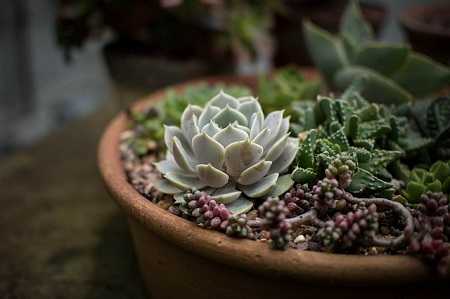
Depending on whether you are watering your succulent inside or outside, the frequency of watering changes. Following are some tips for watering succulents both inside and outside:
Watering Frequency for Succulents Indoors
Compared to those growing outside, indoor succulents need less regular watering. This is due to the fact that indoor settings are often cooler and less dry than outside settings. Here are some suggestions for indoor watering of succulents:
- Water your succulent plants every two to three weeks, or whenever the soil seems dry to the touch.
- Change the frequency of watering: Change the frequency of watering depending on the season and the amount of light your succulent gets. During the winter and during times of low light, succulents require less water.
Watering Frequency for Succulents Outdoors
Compared to those maintained inside, succulents planted outdoors need more regular watering. This is due to the fact that outside surroundings are often dryer and hotter than inside ones. The following recommendations are for watering succulents outside:
- Every 7–14 days, or whenever the soil seems dry to the touch, water your succulent plants.
- Change the frequency of watering: Change the frequency of watering in accordance with the season and the climate. In hot, dry weather as opposed to cold, rainy weather, succulents need more water.
Watering Frequency for Succulents in Containers and In-Ground
Succulents grown in pots and those grown in the ground may need different amounts of watering frequency. Because the soil in containers dries out more quickly than in the ground, succulents grown in containers need more watering on a regular basis than those grown in the ground. Here are some recommendations for watering succulents both in the ground and in containers:
- Succulents planted in containers should be watered every 7 to 10 days or whenever the soil becomes dry.
- When the soil seems dry to the touch, water in-ground succulents every 14–21 days.
- Change the frequency of watering: Change the frequency of watering in accordance with the season and the climate.
How Much Water Do Succulents Need?
Succulents may survive with just a little amount of water. Root rot and other issues may be brought on by overwatering. Succulents need the following amounts of water:
- Your succulent plants should get water until the soil is wet but not waterlogged. Make sure the water reaches the roots by thoroughly penetrating the soil.
- Avoid standing water: Standing water may cause root rot in succulent plants, so make sure it doesn’t get there.
- Use the “soak and dry” technique to water your succulent plants. This technique entails soaking the soil with water, letting it dry up entirely, and then watering it once again.
Shapely Succulent Containers
Succulent plants have distinctive shapes and colors, as well as the containers they are grown in. Here are some attractive succulent containers to take into account:
- Terrariums are compact, enclosed pots that provide a distinctive and lovely method to showcase succulent plants. You may use numerous kinds of succulents to make your own unique terrarium since they come in a variety of sizes and forms.
- Hanging baskets: Hanging baskets, particularly trailing types like string of pearls, are a common method to showcase succulent plants. These baskets are available in a variety of sizes and forms and may either be mounted on a pedestal or hung from the ceiling.
- Pots with drainage holes: Make sure the container you choose for your succulent plant includes drainage holes. As a result, more water may drain away and the roots won’t get waterlogged.
- Creative containers: Use unusual objects like teapots, worn-out boots, or even an antique bicycle basket as containers for your succulents. You may use the container to showcase your succulent plant as long as it has sufficient drainage and is the proper size for your plant.
Conclusion
Succulent plants have specific watering requirements that must be taken into careful consideration. Because succulents are adapted to withstand abrasive conditions, either overwatering or underwatering can be harmful. Season, container size, quantity of light, and humidity are just a few of the factors that affect succulents’ watering frequency. You may develop a watering regimen that is appropriate for your plant’s requirements by being aware of these factors. Additionally, you can ensure your succulent plants have the best possible health and growth by picking the appropriate soil and container and adhering to care instructions.
Frequently asked questions about watering succulent plants:
How often should I water my succulent plant?
Numerous factors, including the type of succulent, the size of the pot, and the environment it is in, affect the frequency of watering your succulent plant. Succulents typically need to be watered once every 1-2 weeks, however it’s advisable to check the soil’s moisture content beforehand to prevent overwatering.
How do I know when my succulent plant needs watering?
By inserting your finger approximately an inch into the soil, you may measure the moisture content of the soil. It’s time to water your plant if the soil feels dry to the touch. As an alternative, you may evaluate the soil’s moisture content with a moisture meter.
What is the best way to water succulent plants?
Deep but infrequent watering is the ideal method for succulent plants. This entails soaking the soil with water and letting it entirely dry up before watering it again. To regulate the flow of water and make sure it reaches the roots directly, use a watering can or a drip system.
Can I mist my succulent plants instead of watering them?
Since misting does not reach the roots in the soil deeply enough, it is ineffective for watering succulent plants. High humidity levels brought on by misting might also result in fungal infections and plant rot. Succulent plants respond best to watering when the soil is completely soaked.
What type of soil is best for succulent plants?
A soil that drains quickly and does not hold onto water is necessary for succulent plants. To ensure proper drainage, use a soil mixture designed for succulents or a combination of sand, perlite, and potting soil.
Do succulent plants need fertilizer?
Because they were developed to thrive in nutrient-deficient soils, succulent plants do not require frequent fertilization. To encourage growth and blooming, you may treat your succulent plants once or twice a year using a balanced fertilizer.
Can I use tap water to water my succulent plants?
For watering succulent plants, tap water is normally safe. However, if your tap water contains a lot of salts or minerals, over time they can build up in the soil and harm your plants. Change to distilled or filtered water while watering your plants if you see a buildup of salts on the soil’s surface or the tips of the leaves.
How do I know if I am overwatering my succulent plant?
In succulent plants, overwatering can cause root rot and other issues. Yellowing or withering foliage, mushy or discolored roots, and an unpleasant stench coming from the soil are all indicators of overwatering. Reduce the frequency of watering and wait until the soil is totally dry before watering again if you think you may be overwatering your succulent plant.
Also Read :
- Why Are My Succulent Leaves Drooping? (10 Causes And Solutions)
- How to Get Rid of Brown Spots on Succulents (An Easy to Follow Guide)
- Boost Your Succulent’s Growth with the Top 15 Best Succulent Fertilizer
- Top 10 Best Succulent Grow Lights: Illuminate Your Plants with Precision
- Top 10 Succulent Arrangements: Stunning Display Ideas for Green-Thumbed Enthusiasts
- Discover the Best Lego Succulents – Instructions, Price, Set, Light Kit
- Euphorbia Vs Cactus: The Ultimate Battle of Succulent
- Plants that Look Like Aloe Vera – 7 Similar Succulent(Pictures)
- Is Aloe a Succulent – Planting It With Other Succulents?(How)
© 2024 Lotusmagus.com. All rights reserved. This content is protected by copyright. Visit Lotusmagus.com for more information.
